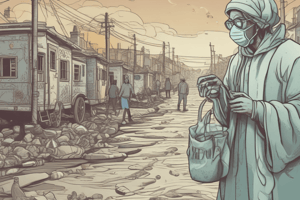Podcast
Questions and Answers
What is a typical characteristic of stool in a cholera infection?
What is a typical characteristic of stool in a cholera infection?
- Sticky, dark brown stool with a strong odor
- Thick, yellow stool with particulate matter
- Scanty, liquid stool with mucus and blood
- Abundant, liquid, foul-smelling, swamp mud color (correct)
Which symptom is primarily associated with cholera?
Which symptom is primarily associated with cholera?
- Intoxication
- Bacteremia
- Severe dehydration (correct)
- Meningitis
Which of the following is a common initial clinical sign of botulism?
Which of the following is a common initial clinical sign of botulism?
- Foul-smelling diarrhea
- Severe dehydration
- Severe abdominal cramping
- Visual disturbances (correct)
What type of cells does botulism primarily affect?
What type of cells does botulism primarily affect?
Which product is commonly associated with botulism cases?
Which product is commonly associated with botulism cases?
What is a defining characteristic of foodborne toxic infections?
What is a defining characteristic of foodborne toxic infections?
Which of the following is a frequently encountered viral diarrhea?
Which of the following is a frequently encountered viral diarrhea?
Picornavirus infections are characterized by which symptom?
Picornavirus infections are characterized by which symptom?
Which infection is NOT classified under protozoal colitis?
Which infection is NOT classified under protozoal colitis?
Which of the following is NOT a form of amoebas in the vegetative stage of development?
Which of the following is NOT a form of amoebas in the vegetative stage of development?
What is the incubation period for Viral Hepatitis A?
What is the incubation period for Viral Hepatitis A?
Which of the following is a main pathogenetic syndrome of viral hepatitis?
Which of the following is a main pathogenetic syndrome of viral hepatitis?
What increase is typically associated with laboratory criteria of the cytolytic syndrome in viral hepatitis?
What increase is typically associated with laboratory criteria of the cytolytic syndrome in viral hepatitis?
Which complication is associated with acute viral hepatitis B?
Which complication is associated with acute viral hepatitis B?
Which therapy is considered part of the comprehensive therapy for patients with dysentery?
Which therapy is considered part of the comprehensive therapy for patients with dysentery?
Which of the following is NOT a main form of amoebiasis?
Which of the following is NOT a main form of amoebiasis?
Which viruses enter the liver through the portal vein?
Which viruses enter the liver through the portal vein?
What is a common complication of botulism that can potentially lead to death?
What is a common complication of botulism that can potentially lead to death?
Which symptom is not characteristic of botulism?
Which symptom is not characteristic of botulism?
Which method is least effective for diagnosing amebiasis abscess?
Which method is least effective for diagnosing amebiasis abscess?
What is a hallmark clinical indicator of the icteric period of acute HAV infection?
What is a hallmark clinical indicator of the icteric period of acute HAV infection?
Which of the following is NOT considered a complication of erysipelas?
Which of the following is NOT considered a complication of erysipelas?
Which symptoms are characteristic of the initial period of rabies?
Which symptoms are characteristic of the initial period of rabies?
What is the primary pathogen factor in Staphylococcal toxicoinfection?
What is the primary pathogen factor in Staphylococcal toxicoinfection?
What is a characteristic feature of generalized lymphadenopathy in HIV infection?
What is a characteristic feature of generalized lymphadenopathy in HIV infection?
Which of the following symptoms could lead to suspicion of HIV infection?
Which of the following symptoms could lead to suspicion of HIV infection?
Which enzyme is NOT involved in the pathogenesis of the immunodeficiency virus?
Which enzyme is NOT involved in the pathogenesis of the immunodeficiency virus?
What is a recognized route of HIV infection?
What is a recognized route of HIV infection?
Which of the following is considered a nonspecific prevention method for HIV infection?
Which of the following is considered a nonspecific prevention method for HIV infection?
Which characteristic is true for endogenous infections?
Which characteristic is true for endogenous infections?
Which type of shock is characteristic of infectious diseases?
Which type of shock is characteristic of infectious diseases?
What is a key preventive measure for infectious diseases?
What is a key preventive measure for infectious diseases?
What are the characteristic clinical signs of the prodromal period of typhoid fever?
What are the characteristic clinical signs of the prodromal period of typhoid fever?
Which of the following changes in blood tests is commonly observed in cholera patients?
Which of the following changes in blood tests is commonly observed in cholera patients?
What is a common complication associated with botulism?
What is a common complication associated with botulism?
What symptom is NOT characteristic of staphylococcal food poisoning?
What symptom is NOT characteristic of staphylococcal food poisoning?
What are the symptoms of the acute form of intestinal amebiasis?
What are the symptoms of the acute form of intestinal amebiasis?
Which method is NOT typically used in the therapy for food poisoning?
Which method is NOT typically used in the therapy for food poisoning?
Which change in the cardiovascular system is observed during typhoid fever?
Which change in the cardiovascular system is observed during typhoid fever?
Which source of infection is responsible for intestinal amebiasis?
Which source of infection is responsible for intestinal amebiasis?
Flashcards are hidden until you start studying
Study Notes
Cholera
- Cholera is a bacterial infection, spread through contaminated water and food.
- Infected individuals may experience severe watery diarrhea, vomiting, and dehydration.
- Cholera can be fatal if untreated, but prompt rehydration therapy significantly improves survival.
Botulism
- Botulism is a serious, life-threatening illness caused by a neurotoxin produced by Clostridium botulinum bacteria.
- The bacterium is commonly found in improperly preserved foods, such as canned goods.
- Botulism paralyzes muscles, including those involved in breathing.
- Symptoms include blurred vision, difficulty swallowing, and muscle weakness.
Foodborne Toxic Infections
- Foodborne Toxic Infections are characterized by short incubation periods and persistent immunity.
Viral Diarrheas
- Most commonly encountered viral diarrheas include rotavirus infections, parvovirus infections, picornavirus infections, viral hepatitis E, poliomyelitis, tetanus, enteric hepatitis, adenovirus infections and influenza.
Picornavirus Infections
- Picornavirus infections are characterized by sudden fever, gastroenteritis, and watery diarrhea.
Protozoal Colitis
- Protozoal colitis is caused by various protozoan parasites, including amoebas, balantidia, giardia, and cryptosporidium.
Amoeba
- Amoebas exist in various stages of development, including trophozoites and cysts.
- Amoebiasis can manifest as intestinal, extraintestinal, or mixed infections.
Viral Hepatitis
- Viral hepatitis is an inflammation of the liver caused by various viruses.
- Hepatitis viruses can enter the liver through the arterial blood or portal vein.
- Hepatitis A and E are transmitted via the fecal-oral route, while Hepatitis B and C can be spread through blood and sexual contact.
- Hepatitis A and E viruses make their way to the liver through the portal vein, while hepatitis B and C viruses enter through the arterial blood.
Erysipelas
- Erysipelas is a bacterial skin infection caused by Streptococcus pyogenes.
- Characterized by redness, swelling, and pain in the affected area.
Rabies
- Rabies is a viral disease that affects the central nervous system.
- Spread through bites or scratches from infected animals.
- Early symptoms include fever, headache, muscle weakness.
- In the later stages, rabies leads to delirium, paralysis, and death.
HIV Infection
- HIV is a viral infection that attacks the immune system.
- Initially, HIV infection may cause flu-like symptoms.
- Over time, the virus weakens the immune system, making individuals vulnerable to opportunistic infections.
- HIV transmission occurs through blood, semen, vaginal fluids.
- Antiretroviral therapy can help to manage HIV infection.
Endogenous Infection
- Endogenous infections are caused by opportunistic organisms normally present in the body.
- They occur when the body's immune system is weakened.
Infectious Diseases
- Shock is a life-threatening condition that can be caused by infectious diseases.
Preventive Measures for Infectious Diseases
- Preventive measures for infectious diseases include: vaccination, proper hygiene, and prompt treatment of infections.
Studying That Suits You
Use AI to generate personalized quizzes and flashcards to suit your learning preferences.





